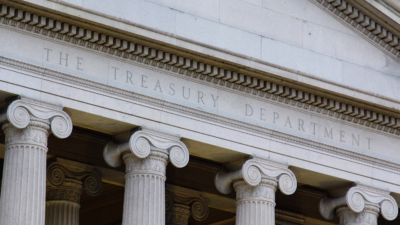American Consumers Feel Moodiest About Their Future in Over a Decade
New Conference Board data released Tuesday showed US consumer confidence down for the fourth straight month.

Sign up for smart news, insights, and analysis on the biggest financial stories of the day.
The economic outlook in America is getting gloomy.
New data released Tuesday showed US consumer confidence down for the fourth straight month and Americans’ faith in their financial futures at a 12-year low. And Moody’s, the last of the major credit rating agencies to maintain a triple-A rating for US sovereign debt, said it sees a weakening fiscal situation in the years to come.
Consumers and Credit (of the Sovereign Variety)
We start with Moody’s, which said in a report Tuesday that widening budget deficits and swelling debt could spell a multi-year decline for the nation’s fiscal health.
Of particular note, the ratings agency forecasts that the ratio of debt to gross domestic product (GDP), a very simple indicator of a country’s ability to pay back its debts, will climb to 130% by 2035 from roughly 100% this year. In the process, the agency forecasts interest payments will grow to 30% of federal spending in 2035, more than triple the 9% in 2021. The agency also noted that trade wars may introduce even further complications: namely, the key role of the US dollar and Treasuries in global financial markets, which helps stabilize debt affordability, could be diminished. The White House is also planning tax cut extensions to the tune of $4.5 trillion, but has pledged to dramatically cut spending.
Then there are consumers, less moved by the seismic forces of sovereign debt markets and more by grocery prices. They, too, don’t have the highest hopes, at the moment:
- The Conference Board said Tuesday that its overall consumer confidence index dropped to 92.9 in March, the lowest reading since February 2021. The Board said the stock market’s performance was likely a contributor to that sentiment: The S&P 500 is down 1.6% this year and the Roundhill Magnificent Seven ETF, representing the major tech stocks that fueled the market’s rally in the past two years, is down 10.4%.
- More dire was the Conference Board’s measure of Americans’ short-term outlook on income, business and labor market conditions. The so-called Present Situation Index fell 9.6 points from February to 65.2, the lowest since 2013 and well below the threshold of 80 that the board says can potentially augur a recession.
Retailers have been sending signals as well. Walmart, which had a strong 2024, nevertheless slashed its profit forecast this year and Target, Macy’s and Best Buy are among other retailers whose executives have offered warnings about future earnings given potential tariff-related costs.
Housewarming: In a bit of sunny news, warmer pre-spring weather and, probably more importantly, declining mortgage rates helped single-family home purchases in the US rebound last month. New home sales rose 1.8% in February, the Commerce Department’s Census Bureau said on Tuesday, as it also revised the January sales figure upward to 664,000 units from 657,000 units.











